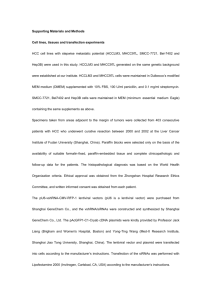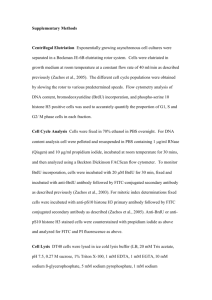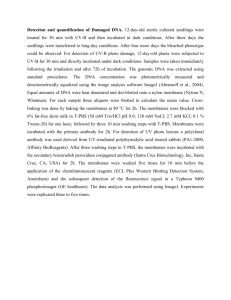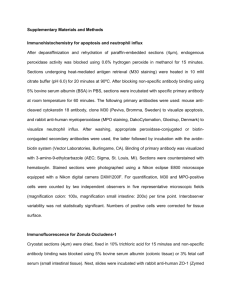Tube Formation Assay for CMECs
advertisement
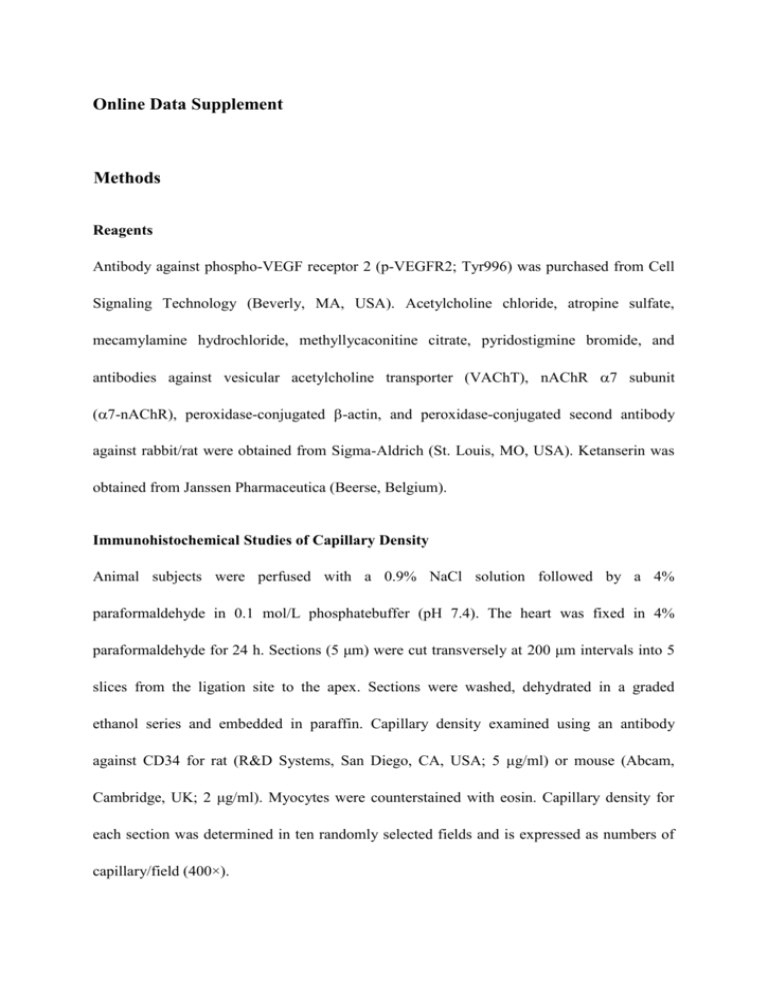
Online Data Supplement Methods Reagents Antibody against phospho-VEGF receptor 2 (p-VEGFR2; Tyr996) was purchased from Cell Signaling Technology (Beverly, MA, USA). Acetylcholine chloride, atropine sulfate, mecamylamine hydrochloride, methyllycaconitine citrate, pyridostigmine bromide, and antibodies against vesicular acetylcholine transporter (VAChT), nAChR 7 subunit (7-nAChR), peroxidase-conjugated -actin, and peroxidase-conjugated second antibody against rabbit/rat were obtained from Sigma-Aldrich (St. Louis, MO, USA). Ketanserin was obtained from Janssen Pharmaceutica (Beerse, Belgium). Immunohistochemical Studies of Capillary Density Animal subjects were perfused with a 0.9% NaCl solution followed by a 4% paraformaldehyde in 0.1 mol/L phosphatebuffer (pH 7.4). The heart was fixed in 4% paraformaldehyde for 24 h. Sections (5 μm) were cut transversely at 200 μm intervals into 5 slices from the ligation site to the apex. Sections were washed, dehydrated in a graded ethanol series and embedded in paraffin. Capillary density examined using an antibody against CD34 for rat (R&D Systems, San Diego, CA, USA; 5 μg/ml) or mouse (Abcam, Cambridge, UK; 2 μg/ml). Myocytes were counterstained with eosin. Capillary density for each section was determined in ten randomly selected fields and is expressed as numbers of capillary/field (400×). Isolation, Identification and Culture of Cardiac Microvascular Endothelial Cells (CMECs) Rat heart was removed and perfused with 10 ml calcium-free PBS. The outer one-fourth of the left ventricle wall and septum was dissected away to remove epicardial arteries and larger penetrating vessels. The remaining tissue was minced in 0.2% type II collagenase (Invitrogen, Carlsbad, CA, USA) and incubated for 40 min at 37°C in a shaking bath. Trypsin (0.02%; Invitrogen, Carlsbad, CA, USA) was then added, and the tissue was sheared 10 times over a period of 30 min. Dissociated cells were filtered through a 100-µm mesh filter, washed with DMEM, and centrifuged at 1,200 g for 5 min. CMECs were resuspended in DMEM supplemented with 20% FBS and antibiotics (penicillin 100 IU/ml and streptomycin 100 mg/ml). The CMECs were seeded in 1% laminin-coated flask. After a 2-h period, attached cells were washed with DMEM to allow differential adhesion and cultured in DMEM with 20% FBS in a humidified atmosphere of 5% CO2 at 37°C. CMECs were grown to confluency (6-7 days) and used after first passage. After isolation and plating on culture plates for 6 days, cells were incubated with 10 μg/ml DiI AcLDL (Molecular Probes, Eugene, OR, USA) in DMEM containing 20% FBS overnight. After washing three times with PBS, cells were fixed with 2% paraformaldehyde for 30 minutes, incubated with a goat antibody against CD34 (R&D Systems, San Diego, CA, USA; 5 μg/ml) for 1 hour, and incubated with FITC-labeled anti-goat IgG (Sigma-Aldrich, St. Louis, MO, USA; 1:200) for 30 minutes. Cells positive for both DiI AcLDL and CD34 were judged to be CMECs. The culture derived as such contained >95% CMECs (Figure 3S). Western Blotting CMECs were lysed with a RIPA buffer (50 mM Tris-HCl, pH 7.5; 150 mM NaCl; 1% Nonidet P-40; 0.1% SDS; and 0.5% sodium deoxycholate) and tissue membrane proteins were extracted with Mem-PER Eukaryotic Membrane Protein Extraction Reagent Kit (Thermo Fisher Scientific, Rockford, IL, USA) for VAChT and α7-nAChR assay. Equivalent amounts of protein (50 μg) were subjected to SDS-PAGE and then transferred to a polyvinylidene fluoride membrane. After blocking with 5% BSA at room temperature for 2 h, the membrane was incubated with specific primary antibodies against VAChT (1:1,000), 7-nAChR (1:3,000), or p-VEGFR2 (1:1,000), at 4°C overnight. After incubation with peroxidase-conjugated second antibody (1:50,000) for 1 hour, enhanced chemiluminescence was carried out (Thermo Fisher Scientific, Rockford, IL, USA). The blots were stripped and re-probed with an antibody against -actin (1:40,000). Tube Formation Assay for CMECs The ECM gel was thawed at 4°C and brought to homogeneity using a cooled pipette. The bottom of the cell culture plate (96-well) was coated with a thin layer of ECM gel (50 μl/well; polymerization time: 60 min at 37°C). CMECs (3×104) in 150 μl DMEM was added on solidified ECM gel and incubated for 6 h at 37°C. Endothelial tube formation was observed under a phase-contrast microscope. Average capillary tube branch points were counted in six random view fields per well. The results are expressed as mean folds of branching compared with the control group. Figures 7-nAChR knockout or SD rats wild-type mice (ketanserin, VAChT, 0.6 mg/kg/d in 7-nAChR food or not) 2w SAD in SD rats 1w (pyridostigmine, 30 mg/kg/d in Regional 2w Myocardial infarction water or not) blood flow 1m 2w 3d SAD or sham 2d operation Vascular endothelial 2w growth factor in SD rats 2w SBP, DBP, HR, BRS, ∆ HR (induced Capillary by atropine sulfate, density 0.03 mg/kg, iv) Figure 1S. A flow chart for animal experiments on angiogenesis. BRS, baroreflex sensitivity; DBP, diastolic blood pressure; HR, heart rate; SAD, sinoaortic denervation; SBP, systolic blood pressure; SD, Sprague-Dawley. 120 60 0 450 HR (beats/min) 120 DBP (mmHg) SBP (mmHg) 180 80 40 0 Sham SAD 300 150 0 Sham SAD Sham SAD Figure 2S. SAD caused no change in SBP, DBP and HR in rats (n=30). Sham, sham operation for SAD. CD34 DiI AcLDL CD34+DiI AcLDL Figure 3S. Identification of primary cultured CMECs. Confluent CMECs were incubated with 10 μg/ml DiI AcLDL overnight. Cells were fixed with 2% paraformaldehyde, incubated with an antibody against CD34 for 1 hour, and incubated with FITC-labeled anti-goat IgG for 30 minutes. Cells positive for both DiI AcLDL and CD34 were judged to be CMECs. The culture contained >95% CMECs. Scale bar=500 μm.
